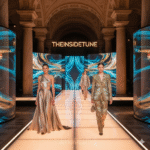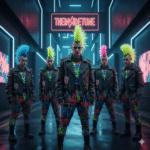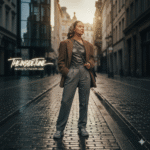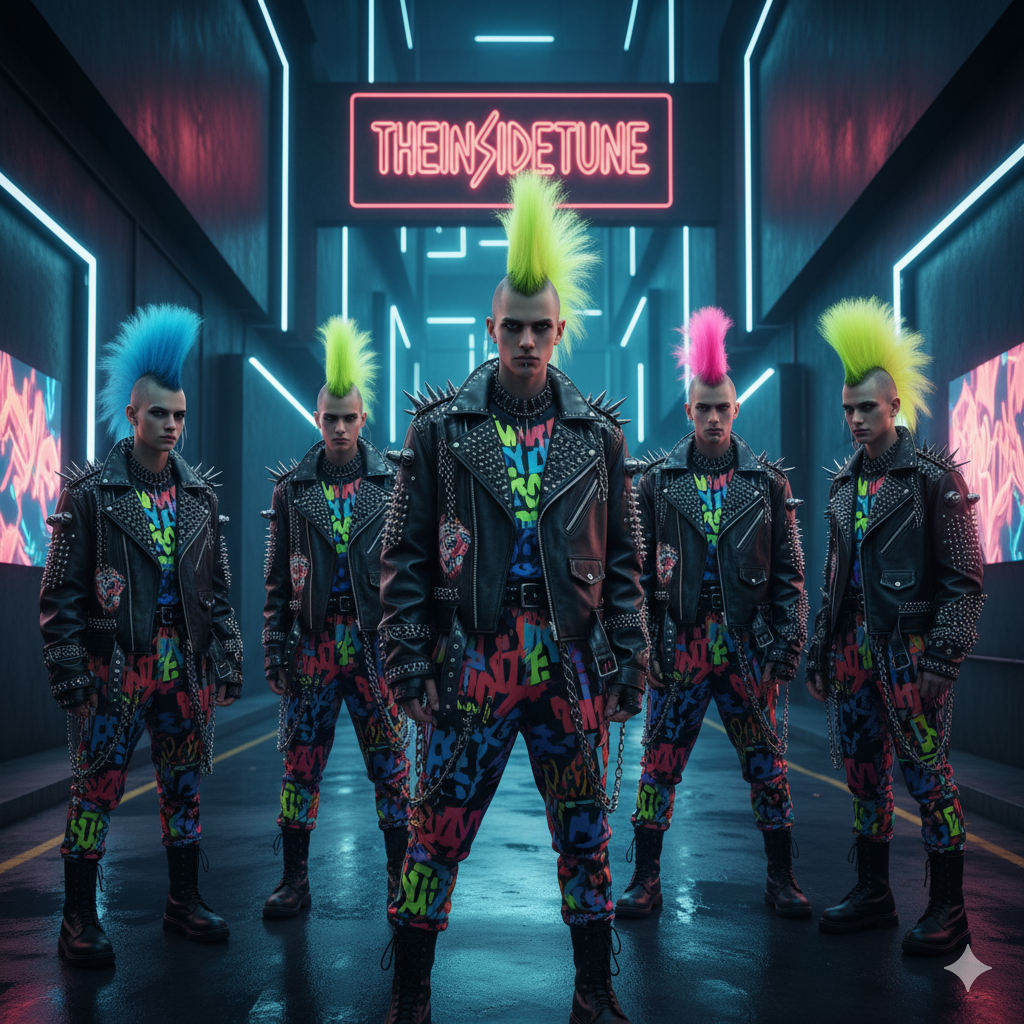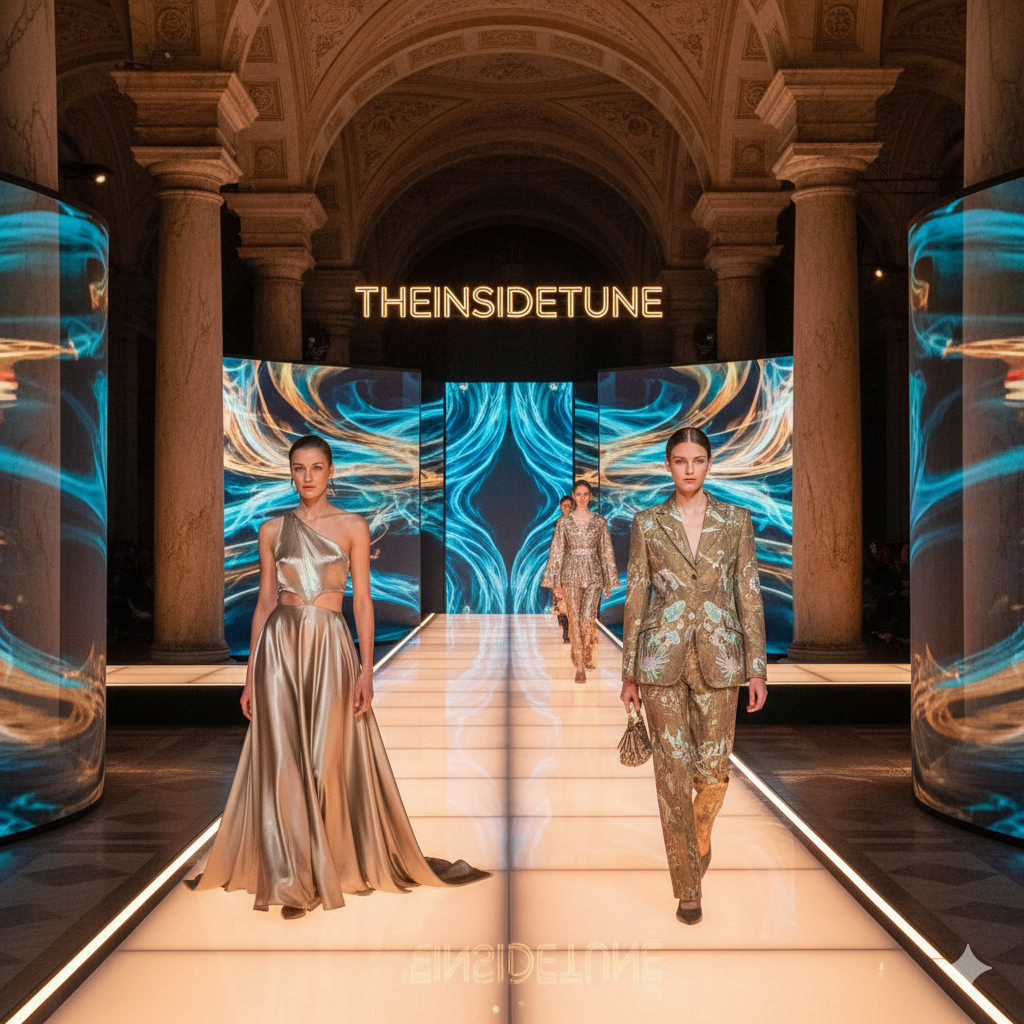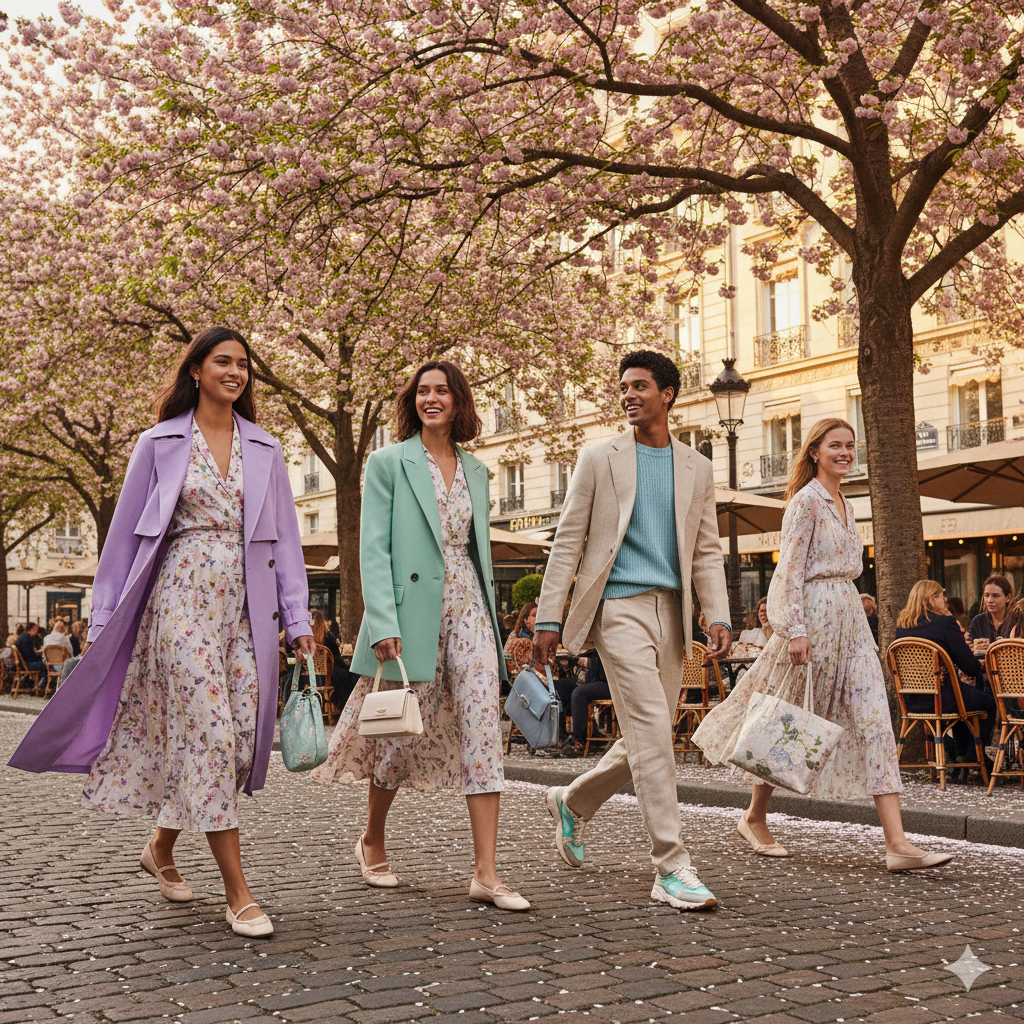Punk Fashion: From Underground Rebellion to Runway Royalty (1970s–2025)
Introduction: Why Punk Fashion Still Makes Us Stop and Stare
There’s a reason punk fashion continues to capture imaginations more than 45 years after it first shocked the world. Unlike most trends that flare up and fade away, punk has always been more than just clothing. It’s a statement, a movement, a refusal to play by anyone’s rules but your own.
Think about it: when you see someone in a spiked leather jacket, safety pins dangling from their ears, and plaid pants tucked into scuffed Doc Martens—you don’t just see fabric. You see defiance. You see history stitched into seams, rebellion painted onto denim, individuality screaming louder than any runway show.
Punk fashion doesn’t whisper; it shouts. And that’s exactly why, even in 2025, it still matters.
But to understand punk’s enduring power, we need to rewind to where it all began: the 1970s, in smoky clubs and gritty streets where young people were fed up with the world as it was—and ready to rip it apart, quite literally, with their clothing.
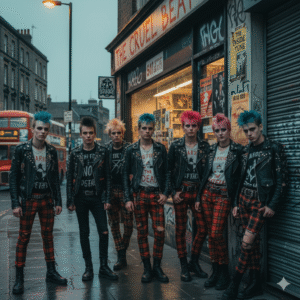
The Birth of Punk Fashion in the 1970s
Picture London in the mid-1970s. The economy was in shambles, unemployment was high, and youth culture felt ignored, voiceless, and boxed into conformity. Music was dominated by polished rock and disco, and fashion leaned toward glamour and sophistication. For working-class teens, this world felt out of reach, irrelevant, and even suffocating.
That’s when punk was born—not in boardrooms or design houses, but in underground clubs, dive bars, and the hands of teenagers armed with safety pins and scissors. Punk wasn’t just about clothes. It was about anger, creativity, and saying “no” to everything society told you to be.
The Sex Pistols and the Shock Factor
No story about punk fashion can start without the Sex Pistols, the infamous British band that embodied punk’s wild energy. With Johnny Rotten snarling on stage and Sid Vicious thrashing his bass, they weren’t just a band—they were a cultural earthquake.
But here’s the twist: the look of the Sex Pistols wasn’t entirely spontaneous. Much of their style came from the vision of Vivienne Westwood and Malcolm McLaren. Westwood, who would later become one of the most influential designers of the 20th century, and McLaren, who managed the Pistols, created clothing that looked like rebellion in fabric form.
At their boutique on King’s Road in London—called SEX, and later World’s End—they sold ripped T-shirts with shocking slogans, bondage-inspired trousers, leather jackets covered in studs, and tartan prints turned upside down. These weren’t costumes. They were weapons, designed to provoke.
DIY: Do It Yourself, Do It Your Way
One of punk’s most defining features wasn’t something you bought—it was something you made. DIY fashion became a punk signature.
Couldn’t afford designer clothes? Rip your jeans and sew them back together with safety pins. Want to make a statement? Grab a marker and scrawl an anti-establishment slogan across your shirt. No money for accessories? Attach chains from a hardware store to your pants, or use a razor blade as a necklace.
It was raw, messy, and powerful. Every rip and tear was intentional, every safety pin a badge of rebellion. Punk showed the world that fashion didn’t need to be polished to be powerful. In fact, the more chaotic, the better.
Punk Hairstyles: Rebellion on the Head
Fashion isn’t only about clothes, and punk made sure of that. Hairstyles were as much a part of the look as leather jackets. The Mohawk—standing tall, spiked with glue or hairspray—became an iconic punk symbol. Brightly dyed hair in neon shades of green, blue, and red screamed individuality. Shaved heads, asymmetrical cuts, and dramatic fringes added to the anti-glamour aesthetic.
Punk hair was loud before you even opened your mouth.
The Politics Woven Into Punk Clothing
Here’s the thing: punk fashion wasn’t random chaos. Every detail carried meaning. It was political, aggressive, and often shocking. T-shirts screamed with phrases designed to offend the establishment. Safety pins, originally practical, became symbolic of resilience and resistance. Tartan, once a traditional Scottish pattern, was twisted into something subversive.
For many punks, fashion was a form of protest against consumerism, capitalism, and a rigid society that told them to conform. Instead of blending in, they stood out. Instead of following rules, they rewrote them.
Punk Crosses the Atlantic
While London gave punk fashion its first breath, New York gave it lungs. On the East Coast, the punk scene grew out of gritty clubs like CBGB, where bands like the Ramones and Patti Smith created their own version of punk identity.
New York punk style was slightly different—less stylized than Westwood’s London version and more grounded in streetwear. Torn jeans, leather jackets, and sneakers became staples, along with band tees that fans proudly wore as badges of belonging.
The New York punk scene was more about functionality—clothes you could wear night after night in sweaty clubs, moshing and moving until dawn. But it carried the same ethos: cheap, DIY, and defiant.
Why Punk Fashion Was Revolutionary
To appreciate punk fashion, you have to remember the context. In the 1970s, mainstream fashion was polished, chic, and often unattainable for working-class youth. Punk ripped through that with clothing that was deliberately ugly, offensive, and cheap.
And yet—because fashion thrives on rebellion—those very qualities would eventually make punk one of the most influential styles in modern fashion history.
It was revolutionary because:
-
It democratized style. Anyone could be punk with scissors, pins, and a marker.
-
It broke taboos. Rips, bondage gear, and shocking slogans pushed boundaries.
-
It gave voice to the voiceless. Punk fashion was protest you could wear.
Punk wasn’t about looking pretty. It was about looking powerful.
Punk Through the Decades – The 1980s, 1990s, and 2000s
The 1980s: Punk Gets Louder, Harder, and Global
If the 1970s gave birth to punk, the 1980s raised it into a rebellious teenager—angrier, louder, and even more extreme. By this time, punk had spread across the Atlantic and taken root in cities around the world. It wasn’t just a London or New York phenomenon anymore. From Los Angeles to Berlin, Tokyo to Sydney, punk was everywhere, and each place gave it its own twist.
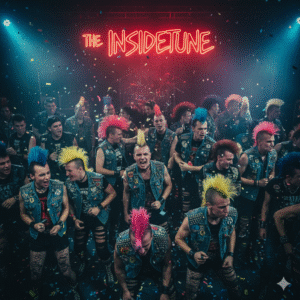
Hardcore Punk: Rougher Clothes for Rougher Sounds
In America, especially, the 1980s ushered in hardcore punk—a more aggressive, faster, and heavier version of the original sound. Bands like Black Flag, Dead Kennedys, and Minor Threat weren’t just pushing the boundaries of music, but also shaping fashion.
Hardcore punk fashion was practical and functional. Ripped jeans, army surplus gear, plain white T-shirts, flannel shirts tied around the waist, and sturdy combat boots or Converse sneakers were common. The look was stripped-down, raw, and durable—perfect for moshing in crowded, sweaty clubs.
Unlike Vivienne Westwood’s more stylized London punk, American hardcore had no interest in theatricality. The clothes weren’t about looking shocking—they were about surviving the pit and resisting mainstream culture.
The Mohawk Reigns Supreme
The Mohawk hairstyle, already making waves in the late ’70s, became even more iconic in the 1980s. Spiked sky-high with soap or glue, sometimes dyed in neon pink or green, it was impossible to ignore. The Mohawk became a global symbol of punk defiance. Shaved heads, liberty spikes, and brightly dyed hair also carried the message: “I don’t care what you think.”
Punk Goes Political
While punk had always been rebellious, the 1980s took it to new political levels. Many punk bands and fans wore their politics on their sleeves—literally. Clothes were painted with anarchist symbols, slogans against war, and messages railing against inequality.
Leather jackets became canvases, painted and patched with the names of favorite bands or political statements. Safety pins were no longer just practical—they were symbolic of solidarity, a reminder that you didn’t need wealth to make fashion work.
Punk Goes Global
By now, punk had spread to Europe, Asia, and beyond. In Germany, punks gathered in squats and underground clubs, wearing patched-up jackets and heavy boots. In Japan, a unique version of punk emerged, blending Western influence with local subcultures, creating looks that were both extreme and distinctly Japanese. Punk wasn’t just British or American anymore—it was truly global.
The 1990s: Punk Meets the Mainstream
The 1990s were complicated for punk fashion. On one hand, underground scenes kept the DIY spirit alive. On the other, mainstream culture began to adopt punk aesthetics—softening its edges and selling it to the masses.
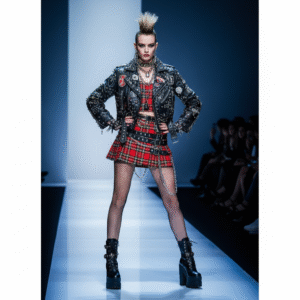
Pop-Punk and the Rise of Accessibility
Enter pop-punk, with bands like Green Day, The Offspring, and Blink-182. Suddenly, punk wasn’t confined to dark clubs—it was on MTV, radio stations, and the covers of glossy magazines.
With that shift, punk fashion became more approachable. Think plaid pants, studded belts, band tees, spiky hair gel, and skate shoes. It was punk-lite: edgy enough to look rebellious in a high school hallway, but not so extreme that it scared suburban parents.
The popularity of pop-punk helped spread punk fashion to a whole new generation of teenagers. Suddenly, malls sold spiked chokers, fishnet gloves, and faux-studded bracelets. Brands like Hot Topic built entire empires selling punk-inspired clothing to young fans who wanted to look rebellious without the DIY mess.
Grunge and Punk Overlap
The 1990s also saw the rise of grunge, a style pioneered by bands like Nirvana, Soundgarden, and Pearl Jam. While grunge wasn’t strictly punk, it borrowed heavily from punk’s ethos of anti-fashion. Flannel shirts, ripped jeans, band tees, and unkempt hair created a look that overlapped with punk.
Where punk was about being loud and aggressive, grunge was more apathetic and disheveled—but both rejected mainstream glamour. For many teens of the ’90s, the two styles bled together, creating wardrobes that mixed punk spikes with grunge flannel.
Punk in Pop Culture
Punk’s influence in the ’90s wasn’t just musical. It showed up in movies, TV, and even high fashion. Characters in teen films wore plaid skirts with combat boots. Supermodels strutted down runways in punk-inspired looks. Fashion magazines featured spreads with edgy makeup and spiked accessories.
In short, punk fashion went mainstream—but in doing so, it lost some of its shock value. What had once been threatening was now trendy.
The 2000s: Punk Goes High Fashion
By the 2000s, punk had already cemented itself in the cultural imagination. But instead of fading away, it transformed again—this time into luxury fashion.
Couture Meets Chaos
Designers began to see the potential of punk aesthetics as more than streetwear. Alexander McQueen, known for his dark and theatrical designs, incorporated punk elements into his runway shows. Jean Paul Gaultier did the same, blending spikes, studs, and plaid into haute couture.
Then came one of the defining moments in punk fashion’s high-fashion journey: the 2013 Met Gala. The theme was “Punk: Chaos to Couture”, and celebrities walked the red carpet in designer versions of punk looks. From spiked gowns to tartan couture, it was official—punk was now part of the fashion establishment.
Emo and Scene Styles
At the same time, subcultures like emo and scene were taking off. These styles borrowed heavily from punk but added their own twists. Tight skinny jeans, band hoodies, studded belts, and brightly dyed bangs became staples for teens in the 2000s.
Music fueled the fashion, with bands like My Chemical Romance, Fall Out Boy, and Paramore influencing fans’ wardrobes. While purists debated whether this was “real” punk, there’s no denying it carried punk’s DNA of rebellion and self-expression.
Celebrities and Punk Influence
The 2000s also gave us celebrities who leaned into punk aesthetics. Avril Lavigne was the poster girl for pop-punk style, with her ties, studded bracelets, and heavy eyeliner inspiring countless teens. Meanwhile, artists like Rihanna and Lady Gaga later incorporated punk-inspired looks into red carpet appearances, pushing the aesthetic further into the mainstream spotlight.
The Commercialization of Punk
By now, punk fashion was no longer just subculture—it was a global industry. High street brands sold studded jackets, distressed jeans, and plaid skirts, all marketed as “punk-inspired.” Fast fashion chains mass-produced looks that once belonged only to underground punks with sewing needles and spray paint.
Some saw this as the death of “real” punk fashion. But others argued it showed punk’s adaptability: it could survive in both gritty clubs and glossy magazines, still carrying its rebellious spirit even when sold on a global scale.
Punk’s Core Never Changed
Despite all the transformations—the hardcore aggression of the 1980s, the pop accessibility of the 1990s, and the couture reinventions of the 2000s—one thing remained constant: punk fashion’s heart.
At its core, punk has always been about:
-
Individuality – Dressing for yourself, not for approval.
-
Rebellion – Using clothing to challenge norms.
-
Creativity – DIY, customization, and making fashion personal.
-
Defiance – Standing out, even when it makes people uncomfortable.
That’s why, no matter how commercialized punk became, it never truly lost its power.
Punk Meets High Fashion + The Designers Who Defined It
From Rebellion to Runway
When punk first exploded in the mid-1970s, the last place anyone expected to see ripped shirts, bondage trousers, and safety pins was on a Paris runway. Punk was dirty, defiant, and designed to upset polite society. High fashion, on the other hand, thrived on elegance, polish, and exclusivity.
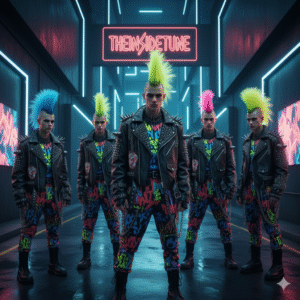
And yet, fashion thrives on rebellion. What begins on the street, raw and unpolished, eventually makes its way into the hands of designers who see its potential. That’s exactly what happened with punk. Within a few decades, what was once dismissed as “anti-fashion” became a core influence on some of the most important designers in the world.
Vivienne Westwood: The Queen of Punk Fashion
No conversation about punk fashion and designers can start anywhere but with Vivienne Westwood. She didn’t just design clothes; she dressed an entire movement.
In the 1970s, Westwood (along with her partner Malcolm McLaren) ran the infamous shop on King’s Road in London. The store went through several names—Let It Rock, Too Fast to Live Too Young to Die, SEX, and later World’s End—but its essence was always the same: clothing designed to shock.
Westwood’s designs mixed historical references with ripped fabric, tartan prints, leather, and bondage straps. She wasn’t afraid to use taboo symbols—swastikas, nudity, provocative slogans—not because she believed in them, but because she wanted to provoke. Fashion, in her eyes, wasn’t just about looking good; it was about making people think.
By the 1980s and ’90s, Westwood had moved beyond underground punk into high fashion, but she never lost that rebellious streak. Her runway shows were dramatic, theatrical, and bold. She brought tartan to couture, mixed corsets with combat boots, and redefined what rebellion looked like on a global stage.
Even in the 2000s and 2010s, long after punk’s first wave, Westwood continued to inspire new generations with her eco-conscious activism and refusal to conform. She showed the world that pink’s DIY spirit and anti-establishment message could live on—even in high fashion.
c: The Visionary Provocateur
While Vivienne Westwood gets much of the credit for shaping punk fashion, her partner, Malcolm McLaren, was equally important. McLaren wasn’t a designer in the traditional sense; he was more of a cultural provocateur.
As manager of the Sex Pistols, McLaren used clothing as a marketing tool. He understood that ripped shirts and spiked hair weren’t just style—they were performance. He encouraged shock value, dressing the band in clothing from SEX, making their fashion inseparable from their music.
McLaren and Westwood’s partnership was the perfect storm: her design genius combined with his eye for spectacle. Together, they gave punk fashion its first true identity.
Alexander McQueen: The Dark Romantic Rebel
If Westwood was the mother of punk fashion, then Alexander McQueen was its rebellious heir.
McQueen, who came onto the scene in the 1990s, was a designer known for his dark, theatrical, and often shocking runway shows. His collections blurred the line between art and fashion, often leaving audiences stunned—or unsettled.
McQueen took punk’s DNA—its love of chaos, rebellion, and shock—and transformed it into couture. Leather, studs, tartan, and ripped fabrics appeared in his collections, but elevated with tailoring and precision. He once described his work as a way to “empower women,” dressing them like warriors, rebels, and outsiders.
One of his most famous collections, the Highland Rape show in 1995, featured torn lace, shredded tartan, and powerful, confrontational models. While controversial, it was undeniably punk in spirit: defiant, political, and unapologetic.
McQueen showed the world that punk’s anger and defiance could be translated into high art, without losing its bite.
Jean Paul Gaultier: Couture With a Punk Twist
French designer Jean Paul Gaultier was another who embraced punk’s rebellious energy. Known as the “enfant terrible” of fashion, Gaultier spent his career challenging fashion’s norms.
In the 1980s and 1990s, he incorporated punk aesthetics into his couture collections: plaid, leather, corsets worn as outerwear, and unconventional accessories. He loved mixing high and low, often pairing refined tailoring with raw, street-inspired details.
For Gaultier, punk wasn’t just a style—it was an attitude. His designs celebrated individuality, gender fluidity, and nonconformity, echoing punk’s rejection of mainstream standards.
Hedi Slimane: Rock-Chic Punk for the Modern Age
Fast-forward to the 2000s and 2010s, and Hedi Slimane (first at Dior Homme, then at Saint Laurent, now at Celine) brought a refined punk-rock edge to luxury fashion.
Slimane’s designs were sleek, sharp, and skinny—perfect for rock stars and anyone who wanted to look like one. He reintroduced leather jackets, slim-fit jeans, and punk-inspired boots into high fashion, making them staples for a new generation.
Celebrities like Pete Doherty, Kate Moss, and later, musicians like Harry Styles, wore Slimane’s designs, keeping punk’s rebellious DNA alive in a more polished, glamorous form.
The 2013 Met Gala: Punk Officially Goes Couture
If there was ever a moment when punk fashion was crowned part of fashion history, it was the 2013 Met Gala. The theme, “Punk: Chaos to Couture”, celebrated punk’s journey from underground rebellion to luxury runway influence.
Celebrities walked the red carpet in punk-inspired looks from designers like Riccardo Tisci, Donatella Versace, and Burberry. There were spiked gowns, tartan gowns, metallic studs, and bold makeup—all nods to punk’s heritage.
Critics were divided. Some argued that punk, which had always been about DIY authenticity, had no place on a red carpet. Others saw it as proof of punk’s staying power: a movement born in backstreet clubs now influencing the most glamorous night in fashion.
Either way, it was undeniable: punk had become part of fashion’s DNA.
Modern Designers and Punk in the 2020s
Today, in 2025, punk continues to inspire modern designers. But its influence has evolved with the times.
-
Eco-Punk: Many young designers reinterpret punk through sustainability. Upcycled denim, patchwork leather, and repurposed fabrics keep the DIY spirit alive while addressing climate change.
-
Genderless Punk: Designers experiment with gender-fluid collections, breaking down fashion norms—just as punk always did. Oversized silhouettes, skirts for men, and unisex accessories echo punk’s tradition of rejecting rules.
-
Tech-Punk: In an age of digital fashion and wearable tech, some designers bring punk into the future with LED spikes, holographic fabrics, and 3D-printed accessories. It’s cyberpunk meets couture, and it’s catching on.
Runways in Europe, Tokyo, and New York now feature punk-inspired looks with futuristic twists—proving that punk isn’t stuck in the past. It’s still evolving, adapting to new generations who see rebellion in different ways.
Why Designers Love Punk
So why has punk, a style that started with safety pins and ripped jeans, remained such a powerful influence in high fashion?
Because punk is more than clothing—it’s a philosophy. It’s about rejecting conformity, celebrating individuality, and pushing boundaries. These are values designers thrive on. Fashion loves rebellion, and punk has rebellion stitched into its seams.
Every designer who has drawn from punk—whether it’s Westwood’s provocative tartan, McQueen’s dark theatricality, Gaultier’s couture-with-an-edge, or Slimane’s sleek rock chic—has tapped into that same core message: fashion isn’t just about beauty. It’s about power, identity, and attitude.
Punk Accessories & Symbols – The Devil in the Details
If clothes are the canvas of punk fashion, then accessories are the paint splatters — bold, messy, and unapologetically expressive. Punk has never been just about ripped jeans or safety pins; it’s about the little things that turn a look into a statement. The accessories of punk culture are loaded with meaning, rebellion, and attitude. From the chains that clank with every step to the badges pinned with pride, these details transform everyday wear into living protest.
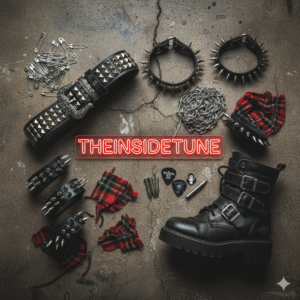
Safety Pins – From Utility to Icon
Perhaps no object is more synonymous with punk than the humble safety pin. What began as a cheap, practical fix — used to hold together torn clothing — quickly became a symbol of defiance. In the mid-70s, punks would pierce their ears, noses, or lips with safety pins, rejecting the idea that body jewelry had to be polished or expensive.
Vivienne Westwood and Malcolm McLaren’s designs for their boutique SEX famously played with safety pins, turning them from accidentals into intentional accessories. By the time the Sex Pistols were photographed draped in safety pins, they had become a visual shorthand for “we don’t care about your rules.” Even today, the safety pin is more than an accessory — it’s a political and fashion statement.
Chains, Studs, and Spikes – Armor of Rebellion
One of the most enduring elements of punk style is its love of metal hardware. Chains dangled from belts, crisscrossed on jackets, or hung from wallets. Studs and spikes transformed ordinary boots, belts, and collars into something aggressive and untamed.
The appeal wasn’t just aesthetic — it was about power. In a world where punks felt marginalized or overlooked, these spiked bracelets and studded chokers were like armor, creating a sense of toughness and danger. You couldn’t ignore someone walking into a room with a leather jacket covered in razor-sharp studs.
Designers like Alexander McQueen, Jean Paul Gaultier, and Balmain later incorporated studs and spikes into their collections, proving punk’s influence runs deep. Today, you’ll see studs not just in underground gigs but on luxury handbags, blazers, and high heels — a sign of how punk’s rough edges got smoothed into mainstream appeal.
Badges and Patches – Voices on Fabric
If punk had a social media platform before Instagram, it was badges and patches. Jackets and bags were plastered with them, turning clothing into walking billboards of identity. Whether it was a band logo (The Clash, Dead Kennedys, or The Ramones), a political slogan, or a handmade patch declaring “No Future,” these little accessories told the world exactly where you stood.
Unlike mass-produced luxury items, patches were often DIY. You’d cut out a piece of fabric, scribble or stencil your message, and sew or safety-pin it to your jacket. This personal, handmade approach was key — your look was your protest, and it was unique to you.
Today, patches are still a huge part of punk fashion, with vintage denim jackets covered in DIY art being highly sought after. The act of customizing your clothing has spread to other fashion subcultures too, from streetwear to skatewear, proving punk’s influence lives on.
Boots and Creepers – Footwear with Attitude
Ask anyone to picture punk footwear, and two things come to mind: Doc Martens and Converse Chuck Taylors. These shoes were durable, cheap (at least in their early days), and already associated with working-class youth before punk adopted them.
-
Doc Martens: With their thick soles and sturdy build, Docs were the perfect mix of functional and rebellious. They became punk’s stomping ground shoes, literally. Black, cherry red, or covered in paint and slogans, they gave punks an unmistakable stomp.
-
Chuck Taylors: Light, affordable, and easy to customize with marker pens or patches, Chucks became another punk favorite.
-
Creepers: With their thick soles and ties to the rockabilly revival scene, creepers added another twist to punk footwear, especially in the UK.
Over time, boots became heavily decorated — painted with slogans, covered in studs, or adorned with spikes. Footwear was more than just protection for your feet; it was a statement of identity.
Jewelry and Body Mods – Breaking Taboos
Traditional jewelry was far too polished for punk sensibilities. Instead, punks turned to DIY body modification: safety-pin piercings, homemade tattoos, and heavy use of leather collars and chains. Dog collars, in particular, became iconic, worn proudly around the neck or wrist. They symbolized aggression, but also a tongue-in-cheek mockery of control and authority.
Body modification — tattoos, piercings, and later scarification — became a way for punks to reclaim their bodies from societal norms. At a time when tattoos were still associated with sailors and criminals, punks wore them as badges of honor, embracing what society feared.
Makeup and Hair – Loud as a Megaphone
Accessories weren’t just objects; they were also bodily choices. Punk makeup flipped beauty norms upside down. Black eyeliner wasn’t for subtlety — it was smeared on thick, jagged, and often paired with neon eyeshadow or lipstick. Foundation might be intentionally pale, giving a ghostly or “undead” look.
And, of course, there’s punk hair. The mohawk, liberty spikes, and dyed neon colors weren’t just hairstyles — they were acts of rebellion. Hair dye from cheap brands or even household items (like Kool-Aid or bleach) created shocking hues. Hair became a billboard for individuality, ensuring punks stood out even in a crowd.
Symbols That Stuck
What’s striking about punk accessories is how many of them are still instantly recognizable today. Safety pins, studs, patches, Doc Martens — they’ve become fashion staples. But their punk origins give them a weight that mass-market fashion can’t erase. Every time someone slips on a studded belt or pins a patch to their jacket, they’re tapping into a long history of rebellion, even if they don’t realize it.
Punk in Pop Culture, Media & Music
Punk has never existed in a vacuum. From the very beginning, it’s been a movement that spills into everything — music, film, art, fashion, even politics. The way punk fashion is remembered and reimagined has as much to do with cultural storytelling as with the clothes themselves. To understand punk fashion, you need to see how it lived — in the sweaty mosh pits of underground clubs, on TV screens that shocked middle-class families, in glossy magazines that tried to “tame” it, and in the endless cycle of pop stars who borrowed its attitude to keep their image fresh.
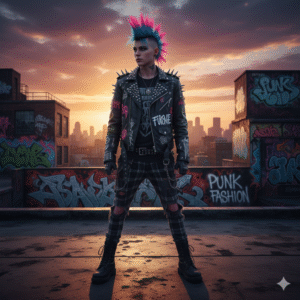
Punk’s Soundtrack: Where Fashion Meets Noise
At the core of punk is music. When people think of punk fashion, it’s often tied directly to the bands who wore it first:
-
The Sex Pistols: Perhaps the most infamous, they weren’t just about music; they were walking advertisements for Vivienne Westwood and Malcolm McLaren’s radical fashion experiments. Sid Vicious’s ripped shirts and studded leather jacket practically defined the punk “look.”
-
The Clash: Unlike the Pistols’ chaos, The Clash fused political messages with style. Military jackets, paint-splattered clothing, and DIY slogans made their fashion a visual protest as much as their lyrics were an audible one.
-
Ramones: On the American side, the Ramones had their own brand of punk fashion — minimalist but iconic. Leather jackets, ripped jeans, and Converse sneakers were all they needed to cement a timeless punk image.
The relationship between music and fashion was symbiotic. Punk bands gave life to the clothes, while the clothes made the bands larger-than-life symbols of rebellion. Fans imitated the looks, and suddenly punk wasn’t just a sound — it was a uniform of belonging.
Punk on the Big Screen
By the late ’70s and early ’80s, punk had moved into film. Some of these movies celebrated the culture; others tried to caricature it. But in either case, punk fashion was front and center.
-
“The Great Rock ’n’ Roll Swindle” (1980) turned the Sex Pistols into cinema icons, showcasing their chaos and style.
-
“Repo Man” (1984) captured the gritty punk aesthetic of Los Angeles, complete with mohawks, leather jackets, and anarchic humor.
-
Later cult classics like “SLC Punk!” (1998) explored the life of American punks in suburbia, showing just how central clothes were to the identity of rebellion.
Even when punk wasn’t the main focus, its influence appeared. Think about dystopian and sci-fi films from the ’80s and ’90s — the ripped clothes, spiked hair, and leather gear often borrowed from punk style to portray “outsiders” or rebels. Fashion in film leaned on punk’s visuals to signal danger, edge, and nonconformity.
Punk on TV: Scandal and Spectacle
Television also played a major role in spreading punk fashion — sometimes accidentally. One of the most famous examples is the Sex Pistols’ appearance on Bill Grundy’s TV show in 1976. Their swearing and scruffy clothes horrified mainstream audiences, but it also cemented punk as a force that couldn’t be ignored.
In the decades since, punk-inspired looks have been staples on MTV, music videos, and reality TV. From Gwen Stefani’s plaid pants and bindis in the ’90s to Billie Joe Armstrong of Green Day’s eyeliner and skinny ties in the 2000s, punk fashion kept creeping back into the spotlight.
Pop Stars Borrow Punk
One of the most fascinating aspects of punk’s cultural journey is how mainstream pop artists adopted punk style when they wanted to look edgier.
-
Madonna in the ’80s: Mixing lace gloves, layered jewelry, and messy hair, her look was heavily influenced by punk’s DIY styling.
-
Kurt Cobain and grunge: Though technically grunge, Cobain’s ripped sweaters and thrift-store finds were direct descendants of punk’s anti-fashion ethos.
-
Avril Lavigne in the 2000s: The pop-punk princess mainstreamed plaid skirts, skinny ties, and heavy eyeliner for a teenage MTV audience.
-
Billie Eilish today: Oversized clothes, neon hair, and chains all echo punk’s love of visual shock and defiance, updated for Gen Z.
What’s striking is how punk, a movement that started as an anti-mainstream rebellion, became a fashion toolkit for pop stars trying to reinvent themselves. Even luxury houses — Balenciaga, Givenchy, Dior — have dressed celebrities in punk-inspired looks for award shows and tours.
Punk in Fashion Media
Fashion magazines, at first, didn’t know what to do with punk. In the ’70s, it was seen as vulgar, dirty, and unmarketable. But as with most subcultures, once editors realized punk wasn’t going away, they tried to package it. By the ’80s and ’90s, photoshoots featuring punk-inspired makeup, hair, and clothes were common in Vogue, i-D, and The Face.
Fast-forward to the 2013 Met Gala, themed “Punk: Chaos to Couture.” Celebrities from Madonna to Rooney Mara walked the red carpet in punk-inspired high fashion by designers like Givenchy and Valentino. It was proof that punk had officially been absorbed into the fashion establishment, even if the original punks would’ve rolled their eyes at couture gowns with studs.
The Meme-ification of Punk
In today’s internet age, punk fashion also thrives in memes, TikToks, and Instagram posts. Subgenres like e-girl or alt TikTok borrow heavily from punk aesthetics: neon-dyed hair, chokers, spiked belts, and oversized band tees. But now, instead of being gatekept in underground clubs, punk aesthetics are spread globally within seconds.
This democratization of punk fashion has its upsides — it’s accessible, fun, and constantly reinvented. But it also raises the question: if everyone can buy a pre-ripped, pre-studded jacket online, is it still punk? Or is punk only authentic when it’s DIY, stitched and spiked by hand?
The Lasting Pop Culture Impact
Whether in a Hollywood film, a music video, or a TikTok trend, punk fashion’s role in pop culture has always been about visual disruption. Even if its meaning shifts — from anti-establishment anger to Instagram-friendly style — the essence remains: punk grabs attention, challenges beauty norms, and refuses to blend in.
Punk Fashion in 2025 – Evolution & Future
Punk may have started in the sweaty clubs of London and New York in the mid-1970s, but here we are, almost fifty years later, and the spirit of punk still refuses to die. It’s shifted, rebranded, been borrowed by high fashion and filtered through Instagram trends — but at its core, punk fashion remains a symbol of rebellion and individuality. The question isn’t whether punk still exists in 2025. It’s how it continues to reinvent itself for a new generation living in an entirely different world.
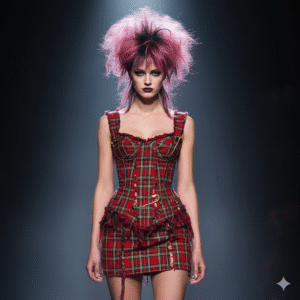
Punk in the Age of Sustainability
One of the biggest shifts in fashion today is the push toward sustainability and slow fashion. Ironically, this makes punk more relevant than ever. The original punks wore ripped clothes, DIY patches, and thrift-store finds not because it was trendy, but because it was accessible and anti-consumerist.
Now, in 2025, those same values resonate with eco-conscious Gen Z and Gen Alpha. Customizing old denim with patches, repairing clothes with visible mending (a modern cousin of safety-pin repairs), and upcycling thrifted jackets into one-of-a-kind statements all feel punk at heart. What was once an act of defiance is now also an act of responsibility — punk as sustainable fashion.
Digital Punks – From TikTok to the Metaverse
In the 1970s, punk fashion spread through gigs, fanzines, and word of mouth. In 2025, it spreads at lightning speed through TikTok trends, Instagram reels, and even digital avatars. Platforms like Roblox, Fortnite, and the broader metaverse now allow users to style avatars in punk looks — neon mohawks, studded jackets, leather boots — bringing punk into the digital fashion world.
Online, punk isn’t just about music or clubs anymore; it’s about creating digital alter-egos that push against aesthetic norms. Digital punk avatars with wild hairstyles and outrageous clothing are as much about identity today as patched jackets were in 1977.
Luxury Punk – High Fashion Still Loves It
Punk has always had a complicated relationship with high fashion. In 2025, luxury designers still borrow heavily from punk’s visual language. Runways this year from brands like Balenciaga, Vetements, and Rick Owens featured models in oversized leather, safety-pin details, distressed fabrics, and exaggerated studs.
But it’s not just visual. High fashion continues to channel punk’s attitude — the sense of irreverence, irony, and rebellion. Think of Balenciaga’s dystopian streetwear, or Marine Serre’s repurposed fabrics with bold graphic designs. The runway punk of today is more polished, but it carries the DNA of the original anti-fashion ethos.
Subgenres Still Thrive
Just as punk splintered into post-punk, hardcore, and goth in earlier decades, 2025 has its own subgenres of punk fashion:
-
Cyberpunk-inspired looks: Neon hair, metallic fabrics, and tech-driven accessories are hugely popular in streetwear and cosplay.
-
Goth-punk hybrids: Dark makeup, lace, and Victorian influences collide with studded jackets and combat boots.
-
Queer punk aesthetics: Punk has long been a home for LGBTQ+ expression, and today’s drag, queer street fashion, and pride looks often incorporate punk elements like harnesses, chokers, and bold makeup.
-
DIY TikTok punk: Young people documenting how they thrift, distress, and repurpose clothes — keeping punk’s hands-on spirit alive.
Each of these branches shows how punk evolves without losing its backbone: self-expression, defiance, and creativity.
Everyday Punk – Mainstream but Still Edgy
It’s easy to spot punk influence in mainstream 2025 fashion:
-
Leather jackets never went out of style.
-
Chunky boots, especially Dr. Martens, are still bestsellers.
-
Plaid skirts and fishnet tights have returned as staples in youth street fashion.
-
Spiked chokers, safety-pin earrings, and studded belts appear not just in alternative stores but in mall chains and online fast-fashion sites.
This raises an age-old question: when punk is everywhere, is it still punk? The truth is that punk fashion has always lived in the tension between authenticity and co-option. For some, punk will always be DIY, underground, and resistant to commercialization. For others, it’s a style toolkit — a way to borrow rebellion for a night out. Both versions coexist in 2025.
Punk and Politics in 2025
It would be impossible to talk about punk fashion today without touching on its political edge. The original punks weren’t just angry at music charts; they were angry at unemployment, class inequality, and authority. Today’s young punks carry forward that legacy, using fashion to make statements about climate change, LGBTQ+ rights, racial justice, and anti-capitalism.
Clothing with painted slogans, jackets patched with protest art, or accessories made from recycled materials aren’t just trendy — they’re part of punk’s living activism. Punk in 2025 is less about spitting onstage and more about shouting through fashion against systems that feel broken.
Punk’s Future – Why It Still Matters
So what’s next? If history has taught us anything, punk won’t fade away. It will keep mutating, absorbing new technologies, responding to political climates, and inspiring both underground and mainstream fashion.
-
We’ll likely see AI-generated punk fashion designs gain popularity in digital spaces.
-
Punk aesthetics may merge more with futuristic techwear, creating a hybrid of rebellion and sci-fi survival.
-
And yet, at the core, the ripped denim, the studs, the safety pins, and the DIY jackets will remain — because those are eternal.
In other words, punk fashion has grown older, but it hasn’t grown up. And that’s exactly how it’s supposed to be.
Why Punk Still Matters
By now, it’s clear that punk fashion is more than just ripped jeans, spiked hair, or a studded jacket. Those things matter — they’re the recognizable symbols. But if you strip punk down to its bones, what remains is an attitude. That attitude — raw, defiant, and fiercely individual — is exactly why punk fashion still matters in 2025.
Punk Is About Identity
At its core, punk fashion has always been about saying: This is who I am, and I don’t care if you approve. In the 1970s, when society wanted young people to conform to neat suits and tidy appearances, punks ripped up those rules — literally. Today, when social media often pressures people into looking “perfect” or curating a flawless feed, punk still offers an alternative: authenticity, messiness, individuality.
A ripped jacket, a hand-painted slogan, or neon-dyed hair might not seem revolutionary, but for the person wearing it, it’s a form of liberation. Punk fashion empowers people to own their difference rather than hide it.
Punk Bridges Past and Future
Few fashion movements manage to feel both historic and futuristic at the same time, but punk does. Its origins are rooted in a specific moment — the economic struggles, political unrest, and musical explosions of the late 1970s. And yet, every generation rediscovers it in their own way.
Why? Because rebellion never goes out of style. Each new era finds fresh reasons to be angry, to protest, to break rules. Punk is like a wardrobe toolkit handed down through the decades, ready to be customized. Whether it’s safety pins in 1977 or digital punk avatars in 2025, the message remains consistent: we won’t be tamed.
Punk Keeps Fashion Honest
Fashion, at its worst, can be shallow — obsessed with trends, labels, and consumerism. Punk calls that out. Punk fashion doesn’t just play with clothes; it mocks the very idea that fashion should tell us how to look. It forces the industry to question itself.
Even when luxury houses borrow punk aesthetics for runways, there’s always an underlying tension. Punk wasn’t designed to be sold at thousands of dollars a piece. Its roots are in the DIY, the affordable, the thrown-together. That contradiction keeps fashion on its toes. Punk acts like a mirror, reminding the industry not to take itself too seriously.
Punk Is Still Political
It’s easy to see punk fashion as just edgy style — chains, boots, makeup. But punk has always carried political weight. Wearing a patched jacket with a slogan, or boots that defy gender expectations, is an act of protest. Punk gives visual form to anger, frustration, and resistance.
In 2025, as the world faces climate anxiety, rising inequality, and social justice movements, punk fashion remains a way to speak without words. A jacket that says “No Future” in 1977 might now say “Save the Planet” — but the spirit is the same. Punk is a wearable manifesto.
Punk Is Personal
Perhaps the most beautiful thing about punk fashion is that it’s never about perfection. It’s about personal expression. No two punk outfits are ever truly the same. The patches are stitched differently, the slogans are hand-painted, the hairstyles are self-invented. Punk doesn’t demand polish; it demands honesty.
In a world of fast fashion where thousands of people can buy the same outfit in minutes, punk fashion reminds us that style can still be intimate, creative, and one-of-a-kind. It’s not about blending in; it’s about carving out space for yourself.
Why Punk Will Never Die
Every time someone declares punk dead, it reappears. Maybe not in the same ripped shirt or spiked jacket, but in a new form — a new generation’s version of rebellion. That’s because punk isn’t really a look; it’s a mindset. And mindsets don’t die. They evolve.
In 2025, punk matters because it proves that fashion isn’t just about fabric. It’s about power, voice, and resistance. Punk is a reminder that clothes aren’t just what we wear — they’re who we are, and sometimes, who we refuse to be.
Conclusion – Punk Isn’t Just a Style, It’s a Spirit
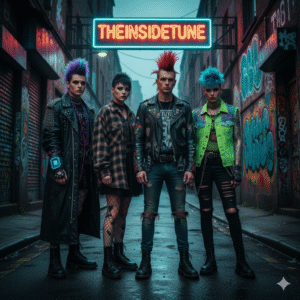
Punk fashion has come a long way from the gritty streets of London and New York in the 1970s. What started as a scrappy, in-your-face rejection of mainstream norms has become one of the most enduring style movements of the past half-century. Yet, through all its twists and turns, one thing has never changed: punk fashion is about freedom.
It’s freedom to rip apart what doesn’t work. Freedom to stitch together something entirely your own. Freedom to wear your anger, your passion, your humor, your politics on your sleeve — sometimes literally.
In 2025, punk fashion is alive in thrifted jackets with fresh patches, in luxury runways that can’t resist studs and spikes, in digital avatars rocking neon mohawks, and in young people who see fashion as protest as much as style. Punk hasn’t faded; it’s multiplied, reshaped, and adapted to each new era. That’s why it still matters.
Because punk isn’t just about what you wear — it’s about how you wear it. With conviction. With defiance. With individuality.
So maybe the real takeaway is this: you don’t have to be in a band, dye your hair lime green, or cover your jacket in studs to embrace punk. You just have to own your style, unapologetically. That’s the essence of punk.
✨ Your Turn: What’s your version of punk? Maybe it’s a safety pin on your jacket, maybe it’s a pair of worn-in boots, or maybe it’s just the courage to dress differently from the crowd. Whatever it is, wear it proudly.
And remember: fashion is always evolving, but rebellion never goes out of style.


